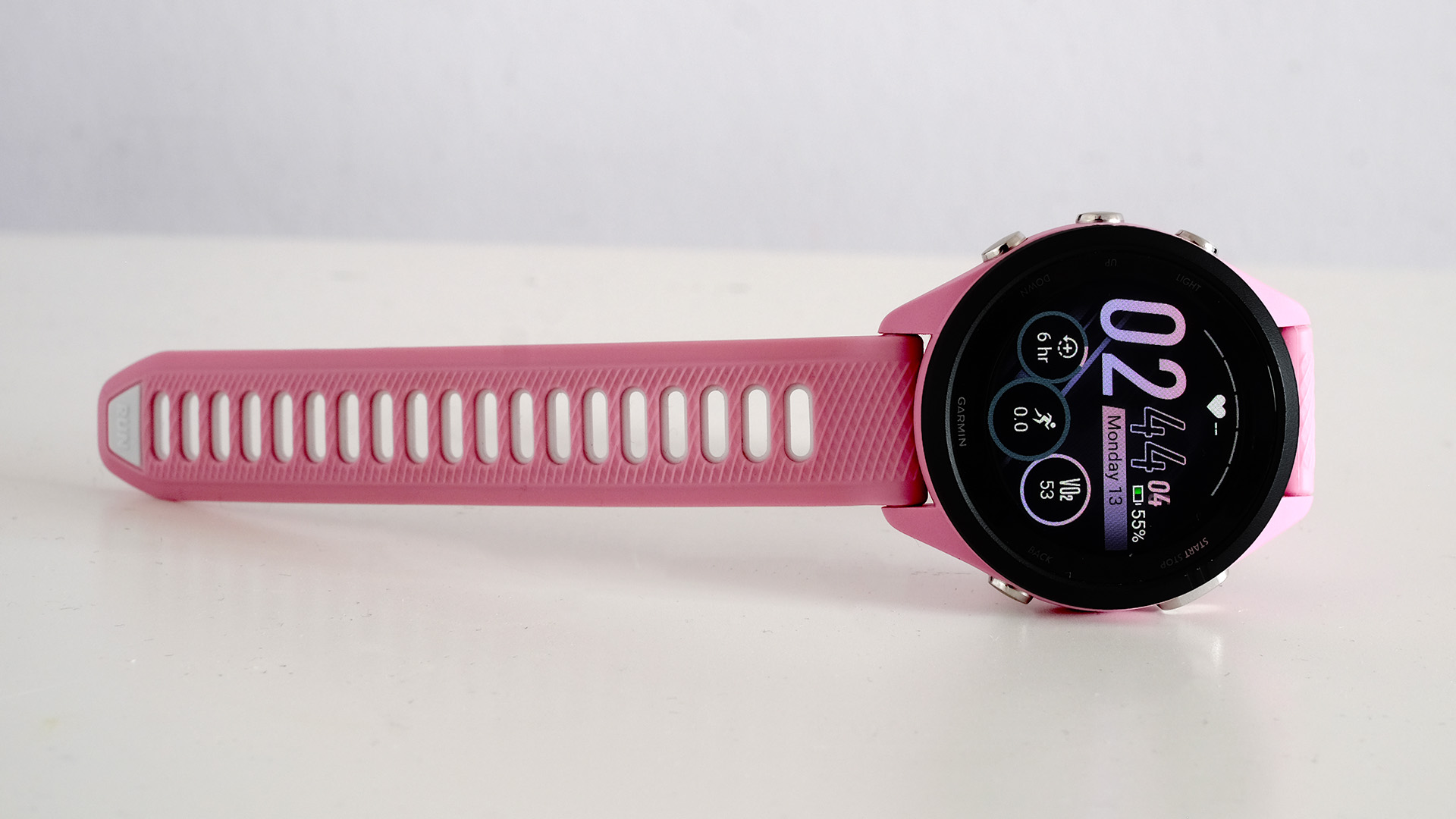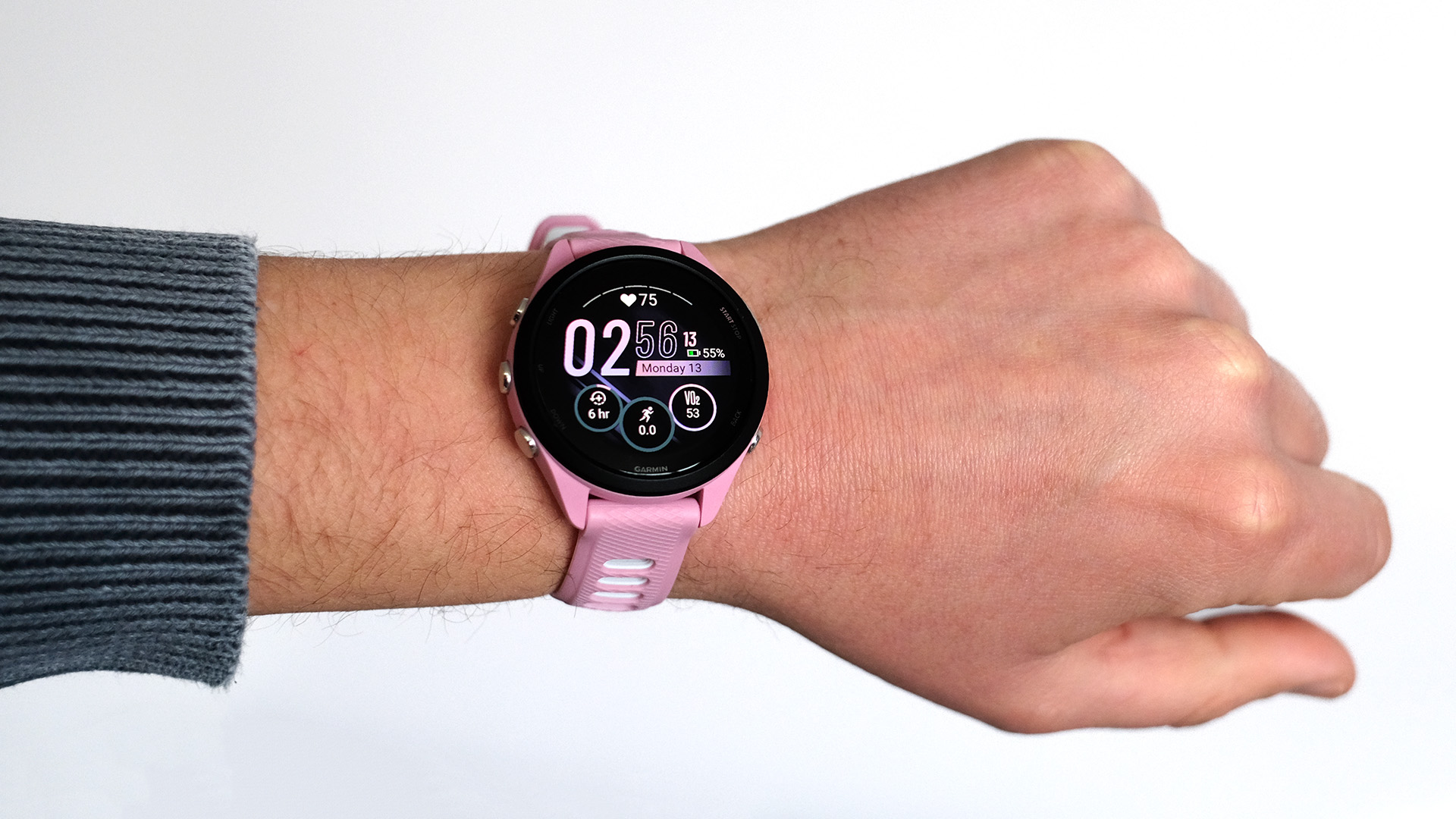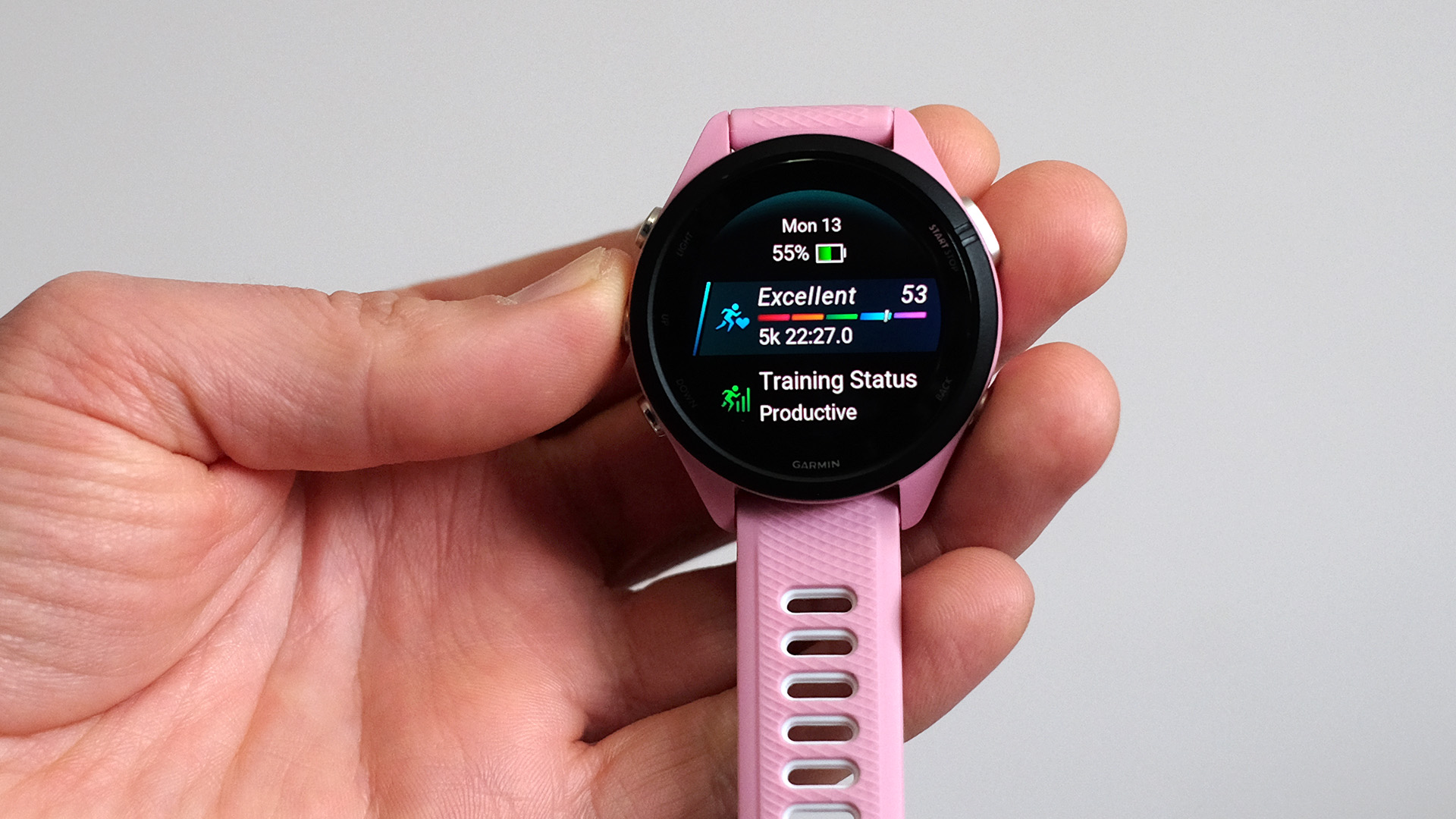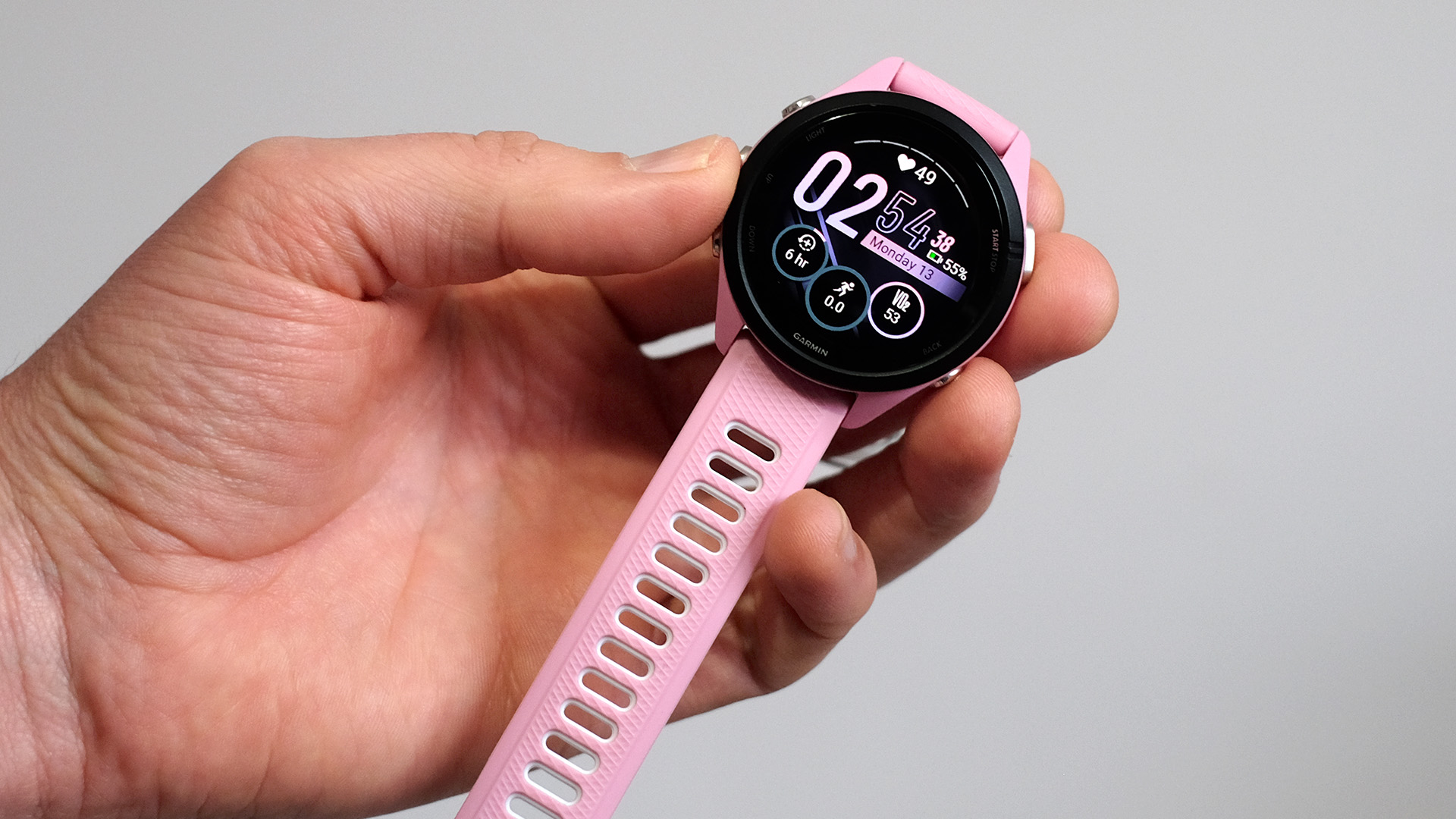Live Science Verdict
An athlete-grade fitness watch with an OLED screen that doesn’t cost as much as the company’s flagship bands, the Forerunner 265 is the watch many people have been asking for.
Pros
- +
Good HR and tracking accuracy
- +
Lots of higher-end exercise features
- +
OLED screen is lovely
Cons
- -
A little pricey for a plastic watch
- -
No on-watch maps
Why you can trust Live Science
The Garmin Forerunner 265 is a watch series we knew would arrive one day. It is an enthusiast fitness watch that has an OLED screen instead of the transflective style seen in almost all Garmins until recent years.
Wondering how it fits in the range? The Forerunner 265 is a Forerunner 255 with OLED. It’s a Garmin Epix alternative that puts much less of a dent in your savings. Or it’s a Garmin Venu 2 that trades in a little design gloss for some more advanced fitness features.
We think it is a killer combo. The model we’re reviewing is the smaller Forerunner 265S, but there’s none of the usual battery life compromise common to smaller watches here — official figures suggest it actually lasts slightly longer than the larger Forerunner 265, making it one of the best fitness trackers of this year.
1.1in or 1.3in AMOLED screen ( 360 x 360, 416 x 416 resolution)
8GB storage
5ATM water resistance
42/46mm watch face
Gorilla Glass 3 screen protection
Up to 15 days battery life
Fiber-reinforced polymer casing
Optical heart rate sensor
Barometric altimeter
There’s one issue. Despite being one of the best Garmin watches and one of Garmin’s more affordable sports watches, this Forerunner 265 is not remotely cheap. At the time of review you can find the Forerunner 955 for just slightly more, and it has some next-level features like on-watch maps.
Garmin Forerunner 265: Price and availability
The Forerunner 265 and Forerunner 265S launched in March 2023, alongside the Forerunner 965.
Both 265-series watches cost $449.99/£429.99, and each come in three colors. For once, Garmin made it pretty simple — with very little to separate the standard and smaller “S” designs, you can just pick based on what will look and feel right on your wrist.

Garmin Forerunner 265: Design and Display
Our Forerunner 265 review unit is the pink Forerunner 265S, the smaller 42mm alternative to the standard 46mm version. It’s still larger than the Pixel Watch.
The build is much like that of the Forerunner 255. Its casing and bezel are plastic — fiber-reinforced polymer as Garmin calls it — and the screen is toughened glass. It’s an older type, though, Gorilla Glass 3. You lose the stainless steel bezel of the Venu 2 series, but this does help keep the weight low.
Our Forerunner 265S weighs just 40g, the standard Forerunner 265 46g. As a result it’s a comfortable watch, although you can likely improve it further by switching out the strap. The supplied silicone strap is a good fit for sports use, but after tightening it up for better heart rate results, it tends to leave a map of indentations on your wrist. We find it hard not to over-tighten this one, for some reason.
The screen is the main event here, though. It’s a 1.1-inch 360 x 360 pixel OLED, or a 1.3-inch 416 x 416 pixel one in the Forerunner 265. While it doesn’t fill out the front of the watch like the Apple Watch Series 8’s display, this little screen has everything we’re looking for.
It’s very sharp, super-colorful, and easily bright enough to work for outdoors exercise sessions on sunny days. This screen’s job is to make an argument for itself over the Forerunner 255’s transflective screen, and it’s pretty persuasive, particularly when it’s a touch display too. The Forerunner 255’s is not.
Not familiar with the difference between OLED and the old transflective memory-in-pixel styles? The OLED Forerunner 265S screen is basically a smartwatch display. It looks fantastic, but it has to ramp-up its brightness to compete with bright environments and consumes significant power when lit. The Forerunner 255’s screen looks duller, has fewer pixels and color is relatively weak, but it uses near to zero battery to display a static image, and only gets clearer outdoors.
You have to use a special “always on” mode in the Forerunner 265S to keep the clock displayed all day, and this more than halves the battery life. However, we’d suggest using this always-on mode as it makes the Forerunner a much better watch — as in something to read the time off, rather than to track your runs. That matters too, right?

Garmin Forerunner 265: Features
The Garmin Forerunner 265 is a fairly hardcore fitness watch. All less "geeky" Garmins you might compare it to have GPS, stacks of fitness modes, sleep tracking and access to the Connect IQ app store, just like the 265.
But what separates the Forerunner 265 from the slightly cheaper, slightly slicker-looking Venu 2? Features like Training Status, Training Readiness and Performance Condition. These make the 265 feel like a real athlete’s watch. It can tell you how ready it thinks you are to train each day, indicate whether you are on track to make fitness progress or not, and assess each workout performance compared to your baseline.
For runners and cyclists it can also suggest workouts each day. All of this might sound a bit intense if you’re new to sports watches, but some of it can really help — suggested workouts are based around your fitness level and how worn-out Garmin thinks you are, for example. You don’t need to have any idea of what you’re doing, and we find Garmin’s suggestions are usually on point.
We also love how lots of Garmin’s exercise modes feel that bit richer than much of the competition — particularly folks who boast about having “100+” modes. Take Strength for example. This weight-lifting mode has a rep counter, and lets you specify the number of reps per set so it can automatically count sets, if you want it to. Some modes like this do little more than measure your heart rate and time spent, and have a guess at calories burnt. Garmin’s Strength mode is far less generic.
The Forerunner 265S does lack a few features from upper-tier Garmin watches like the Forerunner 965 and Fenix 7, though. Maps is the biggie. While, for example, the Hiking mode will show you a “breadcrumb” trail of where you have been, flagship Garmins let you store countries’ and continents’ worth of topographic map data on the watch itself.
You also lose “real time stamina”, which displays how much Garmin thinks you have left in the tank, in workout summaries. There’s no golf mode either. Get a different Garmin if you play, as the company’s golf-specific features are neat.
The Forerunner 265S also lacks the extra smarts of the Venu 2 Plus. It can’t hook up to smart assistants, doesn’t have a microphone or full speaker, just a beeper. As ever, the Forerunner series is exercise and sport-focused.
It does have music support baked-in though, and you get 8GB to load up with tunes and podcasts, through Spotify, Deezer, Amazon Music or your own files.

Garmin Forerunner 265: Performance
The Forerunner 265 has inner hardware we’ve seen in loads of other Garmin watches before. Its heart rate sensor uses two LED blocks and four surrounding light sensors. You’ll find the same arrangement in Garmin’s priciest watches at the moment.
As is seen in most Garmins of the last 12 months, heart rate accuracy is very good. We’re at the stage where the extra reliability of a chest strap doesn’t have all that much impact in most situations. You just have to make sure the strap is on tight enough, and that any long-sleeved clothes don’t start working their way under the sensors.
GPS performance is great too. The Forerunner 265 has Multi-Band GPS, like the Apple Watch Ultra and Fenix 7 series. We set the watch to use its Auto Select mode, though, in order to get the most realistic battery results. This will switch to Multi Band mode only when necessary, as it uses more power.
It’s quick to connect and hasn’t lost signal once during testing. And while mapped routes look less smooth than those of an Apple Watch, that’s just Garmin’s style. As far as we can tell, there’s no accuracy benefit to spending more in Garmin’s line-up after this point.
And, as usual, Garmin’s sleep tracking is nicely presented but has missed out on a few wakeful moments during testing. You can see your sleep score, duration and the display of sleep stages in the Morning Report. This is a relatively recent feature that shows you things like your suggested workout and training readiness — a primer for the day ahead.
Garmin says the Forerunner 265S can last up to 15 days between charges, or as short as six hours if you use the most battery-draining GPS mode and stream music to wireless headphones.
We have used the watch in the manner we think most people should, with the “always on” display mode switched on. Like this, the Forerunner 265S lasted five days, including two roughly hour-long GPS tracked runs.
While that’s nowhere near the 15 days quoted when leaving the screen off most of the time, it’s long enough to make it feel like you are charging the watch roughly once a week. Not bad. Surprisingly, the battery figures are slightly higher for this smaller watch than the Forerunner 265, rated at 13 days. The smaller Samsung Galaxy Watch 4 battery life is much worse than the larger model, and it’s great to that hasn’t happened here.
However, this is the key reason some might want to stick with the non-OLED Forerunner 255. It lasts around twice as long as the 265 in its Always-on mode.

Garmin Forerunner 265: Should I buy the Forerunner 265?
The Garmin Forerunner 265 is perfect for folks who like the idea of a Garmin Epix 2 but find its price way too high. On-watch maps is the only tentpole feature you miss out on, aside from the higher-end build of the company’s priciest watches. The price of the Forerunner 265 may seem a lot to pay for a largely plastic watch, and it is, but it’s not uncommon for Garmin devices.
It’s time to have a talk with yourself. Do you really need full maps on a watch? While we think it is one of the neatest Garmin watch features of all, we can’t say we regularly use it in our daily exercise.
Garmin has also nailed the element we were most concerned about. The Forerunner 265 offers OLED gloss without ruining the battery life, even in the smaller Forerunner 265S. With fairly heavy use it still lasts almost a week.
If this doesn’t fit within the Garmin line-up, you have three other clear options for similar money or less. The Venu 2 is better-looking but loses some of the more enthusiast-geared fitness metrics. The Forerunner 255 is much like the Forerunner 265, but has a transflective non-touch screen rather than an OLED one.
Spend a bit more and you can buy the Forerunner 965, which adds full on-watch maps and a few other software features. From other brands the Polar Grit X is one of the strongest contenders. It has a metal bezel, and costs less, but uses a transflective screen and we prefer Garmin’s software to Polar’s.
Andrew Williams is a freelance journalist based near London. He has written about tech for over a decade, contributing to sites such as WIRED, TechRadar, TrustedReviews, Wareable, Stuff, T3, Pocket-lint and many others. When he's not covering fitness tech, he writes about mobile phones and computing, as well as cameras.












